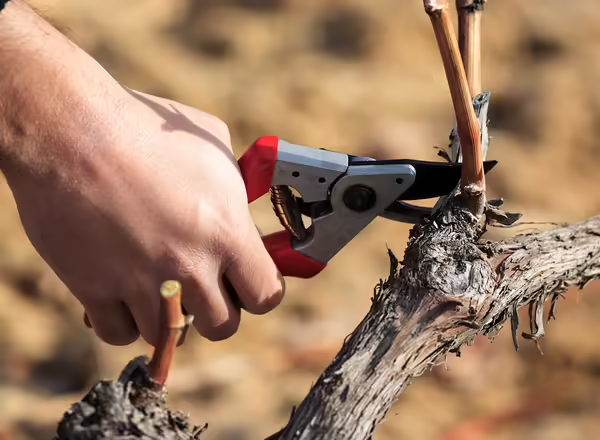
Grape vines produce the greatest amount of high-quality fruit when they have moderate vigor. Weak vines do not have enough strength to produce normal crops. Very vigorous vines spend too much energy on cane growth and not enough energy on fruit production. One way to modify vigor is to reduce the fertilizer rate. However, the best way to adjust the fruit load and maintain proper vigor is through annual pruning.
Proper pruning often results in the removal of 80 to 90% of the wood.
Prune after the coldest part of the winter is past, but before the buds begin to swell. February and early March are usually the best times in Illinois. Pruning during the summer is not recommended except to control excessive growth.
Grapes flower and produce fruit only on one-year-old canes. The most productive wood is on the 4 to 5 buds closest to the base of the cane. The most productive canes have moderate vigor and are about the diameter of a common yellow pencil. Therefore, the goal of pruning is to encourage vigorous new canes to develop, to eliminate unproductive old canes, to train fruiting canes, and to limit the number of buds on the vine. Most gardeners do not prune severely enough.
Regardless of the training system used, American types and French hybrids should be pruned annually using one of the following methods.
Pruning American Hybrids
The “30 + 10” rule is an excellent guide for balanced pruning of ‘Concord’ and other American cultivars. For each vine, thirty buds are left for the first pound of prunings removed and ten buds are left for each additional pound of prunings. For example, a one-pound vine (one pound of prunings removed annually) should have thirty buds left; a three-pound vine should have fifty buds left. Cultivars vary, but one- to three-pound vines are the most productive.
A simpler method of pruning American cultivars is to leave 45 to 60 buds on vigorous plants and 30 to 40 buds on low vigor vines regardless of training method.
Pruning French Hybrids
French hybrids tend to set more grapes per bud than American types; therefore, fewer buds should be left. For these hybrids, a balanced pruning system using a “20 + 5” rule is suggested, that is, 20 buds for the first pound of prunings and 5 buds for each additional pound of prunings.
A simpler method of pruning for French hybrids is to leave 25 to 35 buds on vigorous vines and 20 to 25 buds on the less vigorous plants, regardless of training method. In general, short-fruiting cane spurs with 2 to 7 buds are preferred for the French hybrids. Some shoot thinning and cluster thinning also may be needed on vines with heavy loads of fruit.
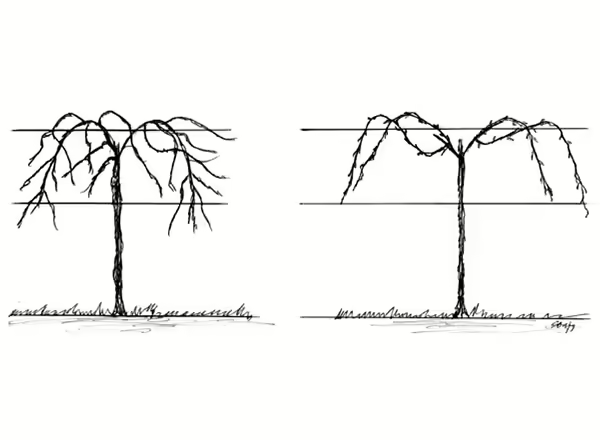
The grape vine is quite adaptable, and the grower has a choice of many different training systems. The most popular system for ‘Concord’ and other American cultivars is the high cordon training system. The vertical shoot positioning system (VSP) is preferred for most French hybrids because of the upright-growth characteristics of their new shoots. Other systems such as the “Geneva Double Curtain” and “Umbrella Kniffin” training systems can also be used for vigorous American hybrid grape vines.
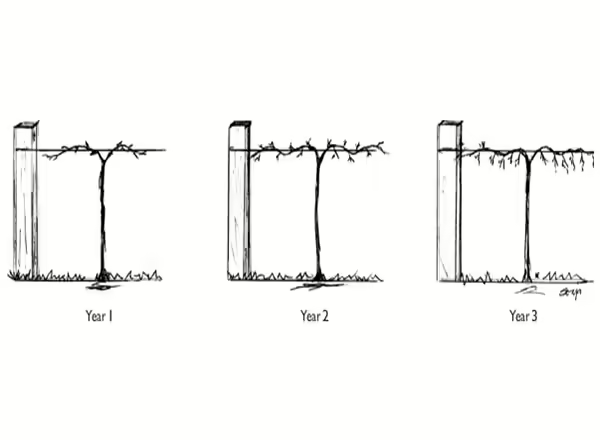
Ease of pruning is the outstanding characteristic of the high cordon system. In this system, the trunk or trunks are trained to a single wire five to six feet from the ground to form cordons or semi-permanent arms. American hybrids with droopy growth habits are well adapted to the high cordon system. Vigorous French hybrids can also be grown with this system.
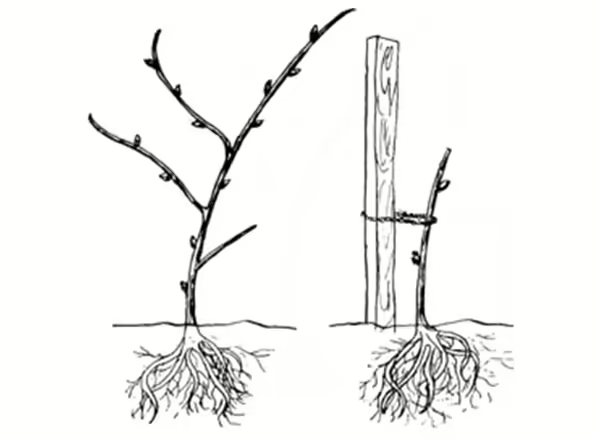
First Year: At planting time, prune the vines to a single stem with two buds. Shoots should grow from each bud. If the trellis is not yet constructed, tie the most vigorous shoots (3 to 4) to a stake four to five feet tall. At the end of the first summer, the shoots should be three to four or more feet high, and may be long enough to reach the top wire of the trellis. Select 2 of the most vigorous canes to reach the trellis.
Second Year: In the early spring while the vine is still dormant, prune off all but the strongest cane. Tie the cane tautly to the top wire of the trellis or to a support. This cane will become the permanent trunk. During the second growing season, the trunk is trained to the wire, pruned back, and two arms are set permanently to form a T-shaped vine. Remove shoots and buds that develop below the wire on the trunk.
Allow the main trunk to reach the top trellis wire, lateral canes to develop on each side. Train one cane each way on the trellis wires by looping or spiraling them two or three times over the support wires and tie with twine or other durable material to hold it in place.

Third Year: Canes growing from the arms are selected and are “spur pruned” to three to four buds each. The vine will have a total of forty to sixty buds. Remove excess canes and spurs. Fruiting canes grow from these buds. If the vines are strong, a small crop can be grown. If the vines are still small, remove all flower buds. During the summer, shoots arising from the fruiting canes are “combed” or positioned to grow downward to form a curtain. Canes growing vertically above the cordon can be removed.
Mature Vines
Mature Vines: After the third year, the vines can be treated as mature vines. In early spring, prune the cordon, called arms, to four feet on each side of the trunk. Canes growing from the cordon (arms) are selected and “spur pruned” to three to six buds each. These spurs should be spaced about 6” apart on each side of the cordon. The vine will have a total of forty to sixty buds depending on the cultivar. Each of these buds is capable of producing two or three clusters of grapes. At pruning, select canes of moderate vigor, one-third to one-half inch in diameter (size of no. 2 pencil), preferably un-branched. Do not select canes less than one-fourth inch in diameter, or “bull canes” that are long, heavy, more than one-half inch in diameter, vigorous, and tend to produce little fruit. Leave two renewal spurs near the main trunk for cordon replacement.
Grapes make excellent dual-purpose vines when trained on arbors, on a pergola for a summer roof, on a fence or wall—almost anything will work. Good varieties, properly cared for, will produce good-quality fruit as well as shade or screen for the home landscape.
An endless variety of sizes and designs is used as supports for grapes. Whatever the design, use materials that permit long-time use with a minimum of repair. Wood, metal, masonry, or a combination of these is ap- propriate. Wire mesh is not recommended: it makes a good support for the vines, but training and pruning operations are extremely difficult. Allow at least eight feet between vines. Spacing too closely results in a jungle like growth that favors the development of diseases, interferes with satisfactory fruiting, and makes pruning difficult. When designing the structure and the subsequent training and pruning, keep in mind that the reason for growing grapes this way is to combine fruit production with shade or screen.
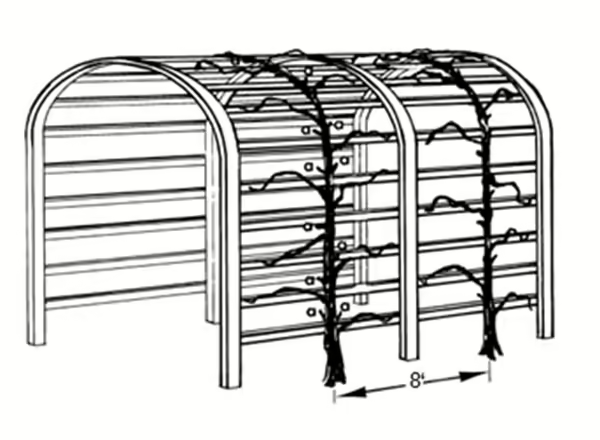
If overhead cover is desired on arbors or pergolas, the permanent single trunk is trained to the top of the structure. Each year, one-year-old canes three or four feet long are distributed at intervals of three feet along this permanent trunk. Renewal spurs of two or three buds are distributed along the trunk in the same manner to produce new fruiting wood from which to select the one-year-old canes for the following year. This type of pruning is not severe enough for best fruit production, but it results in the desired shade. As with other training systems, the amount of bearing wood needs to be adjusted for the vigor of the vine, but remember that most home arbors soon become a tangled mass of vines because of failure to prune heavily enough.
Old vines that have not been pruned for two or more years will be dense and may have several stems or trunks arising from the roots. It may take two or more years to salvage neglected vines. Basically, the job is to select a frame (main trunk, fruiting arms, and renewal spurs) as described earlier. If neglected vines have multiple trunks, remove several each year until one to three remain. Select young canes from the base for the future trunks if the older trunks are malformed. Desirable fruiting wood may be far from the main trunk. Prune out the older portion of the plant gradually, while maintaining moderate fruit production, until the new trunks are ready to take over.